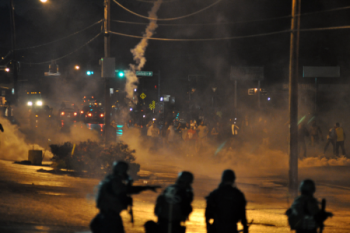Community Justice and Policing: The Role of Conflict Analysis and Resolution Skills
Community Justice and Policing: The Role of Conflict Analysis and Resolution Skills
 Conflict analysis and resolution brings an important lens to the challenge of policing in the US and abroad. How do we begin to heal the fractured relationships between police and communities? Do we need more “law and order” or do we need to address root causes and prepare police with conflict resolution skills to engage communities in collaborative processes to improve security?
Conflict analysis and resolution brings an important lens to the challenge of policing in the US and abroad. How do we begin to heal the fractured relationships between police and communities? Do we need more “law and order” or do we need to address root causes and prepare police with conflict resolution skills to engage communities in collaborative processes to improve security?
Security is a public good. In an ideal world, communities view police as protectors, not predators. One of the most critical indicators of legitimate state-society relations is that local residents in communities view security forces as protecting all civilians equally and not targeting particular groups based on race, class, or ethnicity.
Peacebuilding skills and processes are essential for multi-stakeholder coordination to improve policing. Security forces, including police, can best provide security when they coordinate with and are fully accountable to communities, including religious groups, educational institutes, NGOs, women’s groups, youth groups, and other representatives of community interests. Facilitated dialogue, negotiation, and mediation between community groups, police, and government can significantly improve public safety. A traditional “law and order” approach to policing focuses on bad behaviors and broken laws. Individuals are assumed to make decisions to commit crimes based on personal flaws or individual corruption. In contrast, community-based approaches to justice and policing focus on pattern analysis. They put a single crime in context with similar crimes to understand the larger context in which the breeches are occurring. Such an approach aims to identify the root causes that are motivating individuals or groups to commit crimes. Community justice asks why crime is happening and what can be done to prevent these root causes.
Community justice asserts that no one person or agency can analyse the deeper causes of crime alone. A multi-stakeholder assessment is necessary to develop a full understanding of the causes of crime. There are dozens of factors that contribute to crime, including racial segregation, home ownership, street design, educational quality and opportunities, unemployment rates, levels of economic inequality, and the size of the youth population between ages 16-24. A broad assessment and analysis of crime patterns will identify social, political, and economic factors that contribute to an environment where people commit crimes. Community justice is particularly well suited to address the problems of domestic violence, weapons-based violence, gang violence, and violent extremism since these often are related to broader public issues.
Harvard psychologist James Gilligan’s research on crime prevention identifies three levels of inhibitive action: First, it is important to address the root causes of crime, particularly economic inequality and poverty or class structures that contribute to high crime rates. A second level of prevention addresses the individual needs of those who are at high-risk for committing crime such as treating drug abuse, or healing trauma, especially in children so that they are less likely to become violent or abusers of others. Tertiary prevention works with people who have already engaged in crime, by addressing the major individual factors that contributed to crime, including feelings of shame and humiliation, lack of skills in handling conflict without violence, or lack of education.
Traditional law enforcement defines crime as a violation of state laws, leaves out the victim and community in the justice process, and seeks to determine the guilt of an offender, not the reasons the crime occurred. The goal of traditional law enforcement is to deter crime by punishing the offender. While traditional law enforcement believes that state institutions are responsible for justice, community justice is based on the idea that civil society shares responsibility with the state for implementing justice. While law enforcement sometimes represses civil society in a misguided effort to exert control on a community, community justice believes that civil society needs to be empowered in order to fully contribute to the justice sector. While traditional law enforcement relies on punishment of crimes assuming that this deters future crimes from happening, community justice takes a focus on prevention and a problem-solving approach to crime to identify patterns and address root causes to prevent crimes from happening. Community justice grows out of the field of restorative justice (RJ), which defines crime as a violation or harm to people and prioritises the needs of the victim and community in the justice process. The “RJ” process focuses on understanding the context of the crime and why it happened. The goal of RJ is to determine what actions are needed to address the crime from the perspective of the victim, including offender accountability.
Community justice faces a variety of challenges. Levels of crime correlate with structural problems such as income inequality, corruption, and lack of opportunities. In some places, the justice sector does not work because law enforcement processes (police, courts, and corrections) cannot address the amount of crime happening. The structural problems create a level of crime that is too high for any law enforcement strategy to handle. In some places, there are too few financial and human resources supporting the justice sector. Plagued by corruption or incompetence, courts and corrections do not have enough capacity.
Community justice also does not work when it lacks public support and cooperation. Victims and communities affected by crime are left out of the justice process. Their frustration with law enforcement leads to apathy and a lack of involvement. Civil society plays important roles in achieving the goals of the justice sector. Civil society can reinforce common values, foster social cohesion, and support self-help, self-regulation, peer pressure for good behaviour, and personal responsibility to contribute to public safety, the rule of law, and public order. The public can contribute to the common good and governance, or they can focus on their own personal safety and invest in gated communities or private security guards.
Community policing is an approach that emphasises the relationship between the police and the communities where they serve. Instead of an “us versus them” approach where police and the communities view each other negatively, community policing brings the community and police together. Community policing is implemented in different ways, but has some common characteristics. Some community policing experts claim that police organisations that do take on community policing only include a new unit or an additional bicycle patrol rather than make any of the following organisational changes essential to community policing.
Comparative research on police identifies similar patterns that can improve community safety. The public legitimacy of the police rests on how the police interact with the community. Police who receive minimal training in communication skills to listen, respect, and deescalate tense situations cannot be expected to perform community policing. Training in communication skills to defuse conflict and mediation skills to manage conflict improves police performance and increase community safety. Police officers that are mature and well educated police better than those who are young and inexperienced. Police vetting that excludes police candidates with criminal records police better than those with a record of misdemeanours. Police officers who reflect the gender, ethnic, religion, race or identity diversity of the communities that they serve perform better and improve public safety more than those who attempt to police a community of a different cultural, ethnic, religious, or racial group. Police training that emphasises protection of the Constitution and the protection of all civilians – including both males and females – improves community safety. Increasing the numbers of female police officers can improve reporting of gender-based violence and improves public safety.
Community justice and community policing offer hope in a time of increasing attention to the tensions between police and communities across the US. The quality of the police force in terms of the factors above is more important than the number of police. A small, highly trained, and credible police force can serve a much larger population than a large group of young officers who have received little training. Conflict analysis and resolutions skills should be part of the central curriculum in all police training programs.




